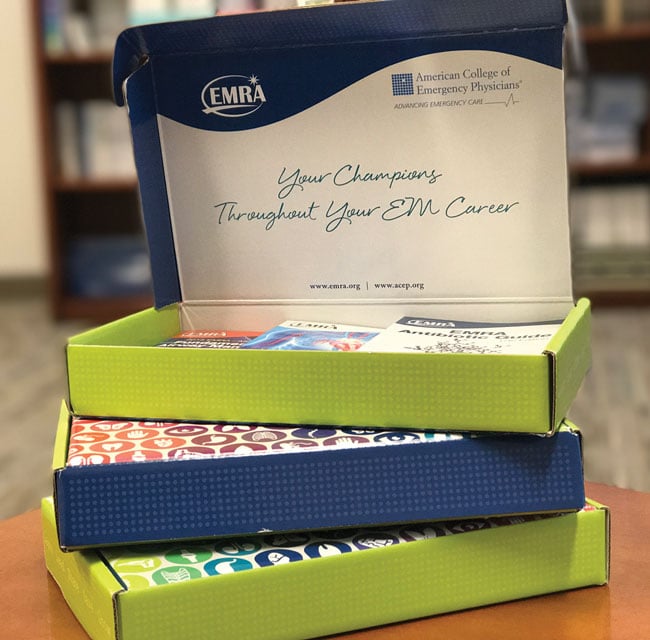EMRA’s Emergency Medicine Interest Group of the Year 2018 - 2019
Rich Dowd, OMS-III, Ohio University Heritage College of Osteopathic Medicine
EMRA MSC Midwest Coordinator 2020-21
The EMRA Emergency Medicine Interest Group of the Year award was created to recognize the hard work and contributions made by the most productive Emergency Medicine Interest Groups (EMIGs). EMIGs everywhere are great complements to their school’s curriculum, affording students opportunities and exposure to Emergency Medicine that they would not otherwise receive. Among a stacked field, the EMIG at Philadelphia College of Osteopathic Medicine (PCOM) stood tall as the inaugural winner of the EMIG of the Year Award.
PCOM’s EMIG was led by Sierra Williams OMS2, Shane Brown OMS2, Pierce Knox OMS2, Pat Boyle OMS2, Sam Traslaviña OMS2, Hilary Gray OMS2, and Spencer Nendza OMS2. We caught up with this crew to learn more about what they accomplished, and give you ideas for how to bring your own EMIG to the next level!
What were some of your EMIG’s more successful events? Unique events?
Our largest event over the past year was our “Intro to EKGs” session run by a PCOM alumnus, Dr. Anthony Moon. The event was open to everyone, and we were able to get the school involved to cover the cost of food. We ended up with about 180 students in attendance! Our members really enjoyed monthly skill labs geared towards the particular system we were covering in class at the time.
The most unique event our EMIG puts on is our weekly sim lab. It’s consistently well-attended which highlights the fact that our members are willing to be challenged and are passionate about learning medicine in a clinical setting. We try to have an attending or a resident available to help run the simulation, but even in their absence, the executive board is able to run the cases. So to me, the amount of practice we receive with simulation is one of the more unique and special aspects to our EMIG.
Lastly, we instituted a monthly Whiteboard Case Series, led by Dr. Josh Baron, in which he presents cases in an EM oral boards format. This event is typically well-attended each month and requires participation and interaction to reveal the correct diagnosis and treatment for the patient!
PCOM was one of only a handful of EMIGs nationally to implement a Journal Club. How did you go about selecting articles to discuss? How was participation and did you find the activity worthwhile?
We held journal club over lunch each month. Despite not having an executive board position specifically designated for research, we usually have one or two members who are passionate about research appraisal. Typically an attending or resident will suggest an article to review or we will pick one related to whatever topic we’re covering in class at the time. We follow a specific format which helps us critique each article in a systematic way. Overall, we saw good participation over the course of the year, usually with a small but consistent group of 10-15 students.
Your chapter has strong engagement within the field of EM outside of simply belonging to the EMIG. How do you promote such engagement and what benefits did your EMIG see because of it?
We recently updated our website and one of the things we added was a page dedicated to national organizations. During our general interest meeting every year we encourage engagement in national orgs, such as EMRA. EMRA membership is especially helpful as a DO student since most of us don’t have an associated EM residency program or hospital and may lack access to EM faculty for advising. For this reason, we also encourage our members to attend EM conferences whether it be ACEP, ACOEP, or others. We put these conferences on our club’s calendar to serve as a reminder.
In terms of tangible benefits from our members’ national engagement, we’ve noticed an uptick in local residency programs and EM physicians reaching out to welcome our participation in various events, whether it be a conference or a workshop. Many of these invitations have stemmed from an interaction between an EMIG member and faculty at various programs while attending a conference.
What advice do you have for newly elected EMIG leadership in running a successful club?
It’s really easy to get overwhelmed because there’s so much that you want to do. We tried to focus on areas within EM that we may not cover or have access to as part of our medical school curriculum. In my opinion, the EMIG exists to provide these experiences to our members and help guide them to success in clerkships and residency.
My best advice would be to have a clear goal in mind of what you want to accomplish over your term. Identify gaps in your school’s curriculum as it pertains to EM and then work that into your plan for the year. Plan ahead of time as much as possible. Then, just have fun with it! For me, I felt very good that we were providing a lot of great educational opportunities to our members that they wouldn’t be exposed to otherwise. Additionally, we utilized class and program liaisons to make sure that we schedule events appropriately given the variability in schedules amongst our members. Often, the OMS1 students who serve as liaisons become the new leaders of the EMIG in the Spring term.
I’ll also add, make connections with your local EM community! Once again, this is especially important as DO students without an associated EM residency program. I’m really adamant about telling our members to jump at any opportunity anytime someone within EM asks you to participate, whether it be as a learner or simply as an ultrasound model. Any kind of connection you can make to other hospitals or residency programs is incredibly important in opening doors to your EMIG and its members, but also individually when it comes time to apply for auditions and then residency. Our EMIG has been extremely lucky to have Dr. Megan Stobart as one of our faculty advisors! This has helped us provide awesome education and mentorship to our members.
The EMIG of the Year Award was instituted in 2019 as a way to recognize the outstanding achievements of the most productive Emergency Medicine Interest Groups (EMIGs) on a regional and national scale, along with the hardworking EMIG medical student leadership who organize valuable EM-related learning and networking opportunities for their student members. Any EMIG associated with an LCME-accredited allopathic or osteopathic medical school is eligible, as well as EMIGs associated with international medical schools. EMIG leaders must make sure to keep track of the events your EMIG puts on throughout the year to maximize point total. Ask your regional representative for more information and specific instructions. Good luck!
Read more about the EMIG of the Year award here and make sure to download a copy of the EMIG Events Tracker to conveniently keep tabs of your EMIG’s scoring throughout the year!
Related Content

Aug 25, 2017
Your Home
The Emergency Medicine Residents' Association EMRA is the voice of emergency medicine physicians-in-training and the future of our specialty and the largest and oldest independent resident organization in the world. EMRA was founded in 1974 and today has a membership over 18,000 residents, medical students, and alumni.






